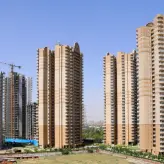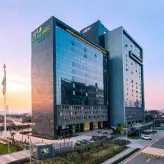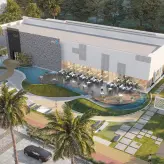The UN Foundation has affirmed that almost 60% will be shifted to urban areas by 2030, posing a considerable threat to ecological balance. There is no denying the fact that increasing urbanization is taking a toll on our environment and human life. The only concrete way to curtail this pressing issue is to adopt green measures, primarily involving the development of green buildings and sustainable architecture.
The concept of sustainable living in urban areas is gaining traction and is likely to become a mandate in the coming years. It involves creating structures that can overcome carbon emissions, ensuring the well-being of residents with effective control over power expenses. This write-up takes a closer look at the trends in green building and sustainable architecture shaping modern spaces’ future.
What Exactly is a Green Building?
A green building refers to an establishment dedicated to eco-friendly practices and infrastructure. Every facet of a green building is environmentally inspired, minimizing carbon emissions and boosting the living experience throughout the life cycle.
Developing a green building is not a matter of merely installing power-efficient devices or air purifiers; it’s a comprehensive approach to reducing the emission of hazardous pollutants and promoting a healthier lifestyle.
Green building development essentially means adhering to green practices such as:
- Selecting eco-friendly construction materials
- Installing energy-efficient devices
- Taking water conservation measures
- Using renewable energy to reduce dependency on conventional power sources.
Also known as eco-building, green building promotes smarter and healthier living while keeping tabs on carbon footprints, leading to sustainable environments.
Trends in Green Building: Shaping the Future of Construction
The concept of sustainable green building no longer exists on paper, as many nations have geared up to take eco-development to the next level. Countries like Singapore and Vancouver are increasingly using green resources to develop sustainable establishments in residential and commercial settings. The use of environmentally friendly construction materials, solar panels, and smart thermostats has become a commonality in the real estate realm.
A prime example of this is the Bullitt Center in Seattle. This astonishing real estate masterpiece has set benchmarks for sustainable practices. Bullitt Center is best known for its aggressive reliance on eco-practices such as the use of solar panels on the rooftop, rainwater conservation, ensuring insulation, and facilitating habitat for native plants and animals.
Underscoring Recent Trends in Green Building
The field of green building is constantly evolving, with innovations and technologies emerging every now and then. Here are some recent trends in green building:
Cross-Laminated Timber (CLT)
CLT has the potential to supersede traditional wood framing. It consists of layers of wood stacked in a way that maximizes durability and stability, creating a robust structure. Derived from locally sourced wood, CLTs are now increasingly used in residential and commercial settings. CLTs are proven to reduce carbon footprints, conserve energy, and promote a healthier environment.
Bio-based Insulation
Bio-based insulation materials originate from natural resources like potato starch, sugarcane, or corn starch. They are best known for keeping the thermal structure intact and can undergo composting at the end of their life cycle. Unlike foam and fiberglass, this material adheres to improved durability, longevity, and safety.
Green Roofs
Green roofs leverage vegetation and are easy to install on any establishment with a flat roof. These are good at absorbing carbon dioxide, minimizing stormwater runoff, and reinforcing habitats for wildlife.
Components Empowering the Trends in Green Building
From material selection, designing, and construction to the touchups, the development of a green building is an all-encompassing approach that goes beyond conventional practices such as installing solar roofs or leveraging rainwater.
It involves considering various components, including natural lighting, ventilation, acoustic design, insulation, finishing materials, etc., that contribute to environmental sustainability. Green building features can include elements like smart faucets, energy-efficient lighting systems, solar panels, rainwater harvesting, vertical gardens, etc.
Speaking of components, here’s how eco-building components contribute to environmental sustainability, empowering trends in green building.
- Building Orientation: The apt orientation of buildings can augment the entrance of natural daylight while lessening the excessive use of artificial lighting.
- Insulation: Better insulation can keep the thermal system intact in cold weather and reduce heat gain in a warm climate, reducing the dependency on heating and cooling.
- Window Design: Double-glazed windows and Low-E glass can considerably lower energy consumption.
How do AIPL Real Estate Projects Contribute to Environmental Sustainability?
Committed to strengthening a greener way of living and reducing resource depletion, AIPL is a forward-thinking real estate company that strongly favors green practices and resources. From NCR to Punjab, the company fosters numerous real estate projects in residential and commercial settings with an increased focus on green design and resources, minimizing carbon emissions significantly.
Most AIPL projects embrace green practices extensively to promote healthier lifestyles, such as verdant gardens, smart lighting, smart thermostats, rainwater harvesting, etc. It is noteworthy that all AIPL’s projects are LEED-certified, a testament to sustainability and energy efficiency.
LEED stands for Leadership in Energy and Environmental Design. It is a globally acknowledged certification that vouches the building for its eco-friendly design and sustainable practices, embodying adherence to a green economy. The LEED certification is formulated and managed by the U.S. Green Building Council (USGBC). It provides a definite framework for creating environmentally sustainable and energy-efficient buildings.
Conclusion
Increasing pollution and environmental hazards have long remained critical concerns for governments. The urban areas account for the majority of pollution, posing a significant threat to the environment. Although several measures have been taken to curtail this pressing issue, nothing has worked well compared to the adoption of green buildings and sustainable architecture. The recent trends in green building showcase that sustainable development will continue to thrive with new technology emerging every now and then.
FAQs
Q1: How profound is the impact of green practices in real estate?
Modern real estate is now aggressively using green practices to ensure environmental sustainability. Being the need of the hour, green practices can help with a number of things, including power expenses, water consumption, and energy savings.
Q2: What are some notable trends in green building that are shaping the future of real estate development?
Some notable trends include the use of smart faucets, the installation of green roofs, vertical gardens, bio-insulations, CLTs, rainwater harvesting, smart lightning, etc.
Q3: What is the role of sustainable architecture?
Sustainable architecture refers to employing green initiatives and components in residential development, elevating environmental sustainability.
Q4: What are the key benefits of developing green buildings?
Developing green buildings can be a concrete step towards environmental sustainability and a reduced carbon footprint. Since such buildings employ several eco-friendly components, significant changes in energy consumption, and resource conservation can be witnessed.
Q5: How promising is the future of green buildings in India?
With the government continuing to intensify its efforts toward energy conservation and resource depletion, green buildings have emerged as a viable solution and are likely to become widespread in the coming years.
Q6: Which real estate projects in India are emerging as green townships?
AIPL, a premier real estate developer, fosters a variety of properties in commercial and residential settings nationwide, with an increased presence in the NCR and Punjab. Most projects leverage green resources to elevate environmental sustainability.
Disclaimer: This content is provided for informational purposes only and is not intended as an advertisement, financial advice, or real estate advice. The views expressed herein are the author’s own and do not necessarily reflect the views of AIPL. While every effort has been made to ensure the accuracy and completeness of this information, circumstances can change, and the information may become outdated. We recommend consulting with a professional advisor before making any real estate decisions. References to specific properties, investments, or locations are for illustrative purposes only. and should not be considered an endorsement or recommendation. AIPL Group and its directors, subsidiaries, officers, employees, agents, affiliates, and partners are not liable for any consequence of any action taken by the viewer relying on such material or information on this blog post.













